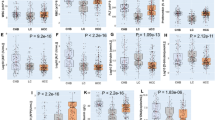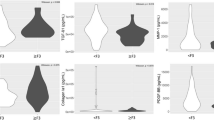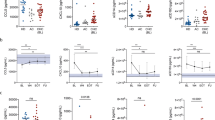Abstract
The hepatitis C virus (HCV) is a major cause of liver disease and the complications of cirrhosis. Liver biopsies, performed prior to the development of liver cirrhosis, characteristically show an inflammatory cell infiltrate with varying degrees of fibrosis. Precisely how HCV infection induces hepatic fibrogenesis is unknown. Recent studies suggest the release of oxidants, cytokines and proteases from the host immune system are key to the development of fibrosis. Macrophages and neutrophils, cells heavily represented in the inflammatory cell response, contain the oxidant generating enzyme myeloperoxidase (MPO). Cellular levels of MPO can be influenced by a functional promotor polymorphism, −463G/A, which precedes the MPO gene. We examined the relationship between this MPO promotor genotype and the degree of fibrosis in 166 patients with chronic HCV infection. All patients had previously participated in clinical drug trials for the treatment of chronic HCV infection. The MPO genotype was determined from cryo-preserved lymphocytes obtained from patients prior to treatment. The degree of fibrosis was estimated from liver biopsy specimens obtained prior to treatment. We found that patients with the MPO GA/AA genotype were more likely to have advanced fibrosis scores compared with those with the GG genotype: Of the patients with GG genotype, 78% (79 of 102 cases) had lower Knodell Fibrosis scores of 0 or 1, compared to 56% (37 of 64 cases) of patients with GA/AA genotype (P < 0.05). The mechanism(s) by which MPO contributes to fibrosis progression remains to be determined.
This is a preview of subscription content, access via your institution
Access options
Subscribe to this journal
Receive 6 digital issues and online access to articles
$119.00 per year
only $19.83 per issue
Buy this article
- Purchase on Springer Link
- Instant access to full article PDF
Prices may be subject to local taxes which are calculated during checkout

Similar content being viewed by others
References
Alter HJ . New kit on the block: evaluation of second-generation assays for detection of antibody to the hepatitis C virus Hepatology 1992 15: 350–353
Alter H . Discovery of non-A, non-B hepatitis and identification of its etiology Am J Med 1999 107: 16S–20S
Poynard T, Bedossa P, Opolon P . Natural history of liver fibrosis progression in patients with chronic hepatitis C. The OBSVIRC, METAVIR, CLINIVIR, and DOSVIRC groups Lancet 1997 349: 825–832
McHutchison JG, Gordon SC, Schiff ER et al. Hepatitis Interventional Therapy Group. Interferon alfa-2b alone or in combination with ribavirin as initial treatment for chronic hepatitis C N Engl J Med 1998 339: 1485–1492
Klebanoff SJ . Myeloperoxidase Proc Assoc Am Physicians 1999 111: 383–389
Casini A, Galli G, Salzano R, Rotella CM, Surrenti C . Acetaldehyde-protein adducts, but not lactate and pyruvate, stimulate gene transcription of collagen and fibronectin in hepatic fat-storing cells J Hepatol 1993 19: 385–392
Milani S, Herbst H, Schuppan D, Surrenti C, Riecken EO, Stein H . Cellular localization of type I, III and IV procollagen gene transcripts in normal and fibrotic human liver Am J Pathol 1990 137: 59–70
Wu J, Zern MA . Hepatic stellate cells: a target for the treatment of liver fibrosis J Gastroenterol 2000 35: 665–672
Poli G . Pathogenesis of liver fibrosis: role of oxidative stress Mol Aspects Med 2000 21: 49–98
Kent G, Gay S, Inouye T, Bahu R, Minick OT, Popper H . Vitamin A-containing lipocytes and formation of type III collagen in liver injury Proc Nat Acad Sci USA 1976 73: 3719–3772
Piedrafita FJ, Molander RB, Vansant G, Orlova EA, Pfahl M, Reynolds WF . An Alu element in the myeloperoxidase promoter contains a composite Sp1-thyroid hormone-retinoic acid response element J Biol Chem 1996 271: 14412–14420
Reynolds WF, Hiltunen M ., Pirskanen M et al. MPO and ApoE4 polymorphisms interact to increase risk for Alzheimer’s disease in Finnish males Neurology 2000 55: 1284–1290
Reynolds WF, Chang E, Douer D, Ball E, Kanda V . An allelic association implicates myeloperoxidase in the etiology of acute promyelocytic leukemia Blood 1997 90: 2730–2737
Nikpoor B, Turecki G, Fournier C, Theroux P, Rouleau GA . A functional myeloperoxidase polymorphic variant is associated with coronary artery disease in French-Canadians Am Heart J 2000 142: 336–339
Reynolds WF, Rhees J, Maciejewski D et al. Myeloperoxidase polymorphism is associated with gender specific risk forAlzheimer’s disease Exp Neurol 1999 15: 31–41
Foster CB, Lehrnbecher T, Mol F et al. Host defense molecule polymorphisms influence the risk for immune-mediated complications in chronic granulomatous disease J Clin Invest 1998 102: 2146–2155
London SJ, Lehman TA, Taylor JA . Myeloperoxidase genetic polymorphism and lung cancer risk Cancer Res 1997 57: 5001–5003
Rojas M, Godschalk R, Alexandrov K et al. Myeloperoxidase −463A variant reduces benzo[a]pyrene diol epoxide DNA adducts in skin of coal tar treated patients Carcinogenesis 2001 22: 1015–1018
Misra RR, Tangrea JA, Virtamo J et al. Variation in the promoter region of the myeloperoxidase gene is not directly related to lung cancer risk among male smokers in Finland Cancer Lett 2001 164: 161–167
Nagra RM, Becher B, Tourtellotte WW et al. Immunohistochemical and genetic evidence of myeloperoxidase involvement in multiple sclerosis J Neuroimmunol 1997 78: 97–107
Cascorbi I, Henning S, Brockmoller J et al. Substantially reduced risk of cancer of the aerodigestive tract in subjects with variant −463A of the myeloperoxidase gene Cancer Res 2000 60: 644–649
Matsuo K, Hamajima N, Shinoda M et al. Possible risk reduction in esophageal cancer associated with MPO −463 A allele J Epidemiol 2001 11: 109–114
Hamajima N, Matsuo K, Suzuki T et al. Low expression myeloperoxidase genotype negatively associated with Helicobacter pylori infection Jpn J Cancer Res 2001 92: 488–493
Le Marchand L, Seifried A, Lum A, Wilkens LR . Association of the myeloperoxidase −463G-->a polymorphism with lungcancer risk Cancer Epidemiol Biomarkers Prev 2000 9: 181–184
Foster CB, Lehrnbecher T, Mol F et al. Host defense molecule polymorphisms influence the risk for immune-mediated complications in chronic granulomatous disease J Clin Invest 1998 102: 2146–2155
Schabath MB, Spitz MR, Zhang X, Delclos GL, Wu X . Genetic variants of myeloperoxidase and lung cancer risk Carcinogenesis 2000 21: 1163–1166
El-Hag A, Clark RA . Immunosuppression by activated human neutrophils. Dependence on the myeloperoxidase system J Immunol 1987 139: 2406–2413
El-Hag A, Clark RA . Down-regulation of human natural killer activity against tumors by the neutrophil myeloperoxidase system and hydrogen peroxide J Immunol 1984 133: 3291–3297
Eckels DD, Wang H, Bian TH, Tabatabai N, Gill JC . Immunobiology of hepatitis C virus (HCV) infection: the role of CD4 T cells in HCV infection Immunol Rev 2000 174: 90–97
Brennan M, Gaur A, Pahuja A, Lusis AJ, Reynolds WF . Mice lacking myeloperoxidase are more susceptible to experimental autoimmune encephalomyelitis J Neuroimmunol 2001 112: 97–105
Brennan ML, Anderson MM, Shih DM et al. Increased atherosclerosis in myeloperoxidase-deficient mice J Clin Invest 2001 107: 401–403
Galeazzi L, Ronchi P, Franceschi C, Giunta S . In vitro peroxidase oxidation induces stable dimers of beta-amyloid (1–42) through dityrosine bridge formation Amyloid 1999 1: 7–13
Daugherty A, Dunn JL, Rateri DL, Heinecke JW . Myeloperoxidase, a catalyst for lipoprotein oxidation, is expressed in human atherosclerotic lesions J Clin Invest 1994 94: 437–444
Abu-Soud HM, Hazen SL . Nitric oxide is a physiological substrate for mammalian peroxidases J Biol Chem 2000 275: 37524–37532
Stuyver L, Rossau R, Wyseur A, Duhamel M, Vanderborght B, Van Heuverswyn H . Typing of hepatitis C virus isolates and characterization of new subtypes using a line probe assay J Gen Virol 1993 74: 1093–1102
Knodell RG, Ishak KG, Black WC et al. Formulation and application of a numerical scoring system for assessing histological activity in asymptomatic chronic active hepatitis Hepatology 1981 1: 431–435
Metavir. Intraobserver and interobserver variations in liver biopsy interpretation in patients with chronic hepatitis C Hepatology 1994 20: 15–20
Author information
Authors and Affiliations
Corresponding author
Additional information
This study was supported by grants to W.R. from the National Institutes of Health (RO1AG17879 and RO1CA72995) and the California Cancer Research Program (97–12013), and clinical research center grants from Scripps Clinic (MO1-RR00833).
Rights and permissions
About this article
Cite this article
Reynolds, W., Patel, K., Pianko, S. et al. A genotypic association implicates myeloperoxidase in the progression of hepatic fibrosis in chronic hepatitis C virus infection. Genes Immun 3, 345–349 (2002). https://doi.org/10.1038/sj.gene.6363880
Received:
Revised:
Accepted:
Published:
Issue Date:
DOI: https://doi.org/10.1038/sj.gene.6363880
Keywords
This article is cited by
-
The Cystic Fibrosis Neutrophil: A Specialized Yet Potentially Defective Cell
Archivum Immunologiae et Therapiae Experimentalis (2011)
-
Reactive oxygen and nitrogen species induce protein and DNA modifications driving arthrofibrosis following total knee arthroplasty
Fibrogenesis & Tissue Repair (2009)
-
Role of host genetics in fibrosis
Fibrogenesis & Tissue Repair (2009)
-
Host genetic determinants in hepatitis C virus infection
Genes & Immunity (2004)
-
Looking back and looking forward
Genes & Immunity (2003)



